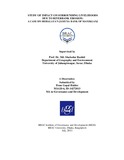Study of impact on surrounding livelihoods due to riverbank erosion: a case on Shibalaya’s Jamuna Bank of Manikganj

View/
Date
2015-07Publisher
BRAC UniversityAuthor
Halder, Prem GopalMetadata
Show full item recordAbstract
The Jamuna is the lowest part of the Brahmaputra River. It enters into Bangladesh at
Nageshwari Upazila of Kurigram district and ends at Aricha while confluenceing with the
Ganges. It is the most dynamic among the rivers of Bangladesh and considered as the largest
sand-bed braided rivers in the world which is complex and chaotic by nature. The annual
erosion along the banks of this river is the highest among all the rivers in Bangladesh having a
profound impact on the livelihoods of the riverine community of our country.
Riverbank erosion is one of the most unpredictable, critical and complex type of disaster, that
takes tolls less in lives but more in livelihood as agricultural land and homesteads along with
other livelihood options that are evacuated. The study was conducted in three mauzas namely
Char Ganga Prasad, Char Shibalaya and Kanaidia covering an area of 7.2 square kilometers of
Shibalaya upazila of Manikganj district which is the most severe erosion phone area of
Bangladesh. In this study an attempt was taken to find out the trends of riverbank erosion, its
impact on major physical and cultural features of the study area and livelihoods of the people
living along the banks of the river in association with difficulties arises from Riverbank Erosion
(RBE). The study employed massive primary and secondary data sources to find out the impact
of river erosion on livelihoods of the community people of this vulnerable char region. Primary
data were collected through structured and semi-structured questionnaire from focal group
discussion, key informant information and informal discussion with the local people of the
study area to understand the adverse effects of bank erosion on the livelihoods of the
surrounding peoples. On the other hand, tracking through Global Positioning System (GPS)
along with mauza maps give the current bank line and image analysis from Google Earth gives
the amount of area eroded for different time periods. A series of maps on RBE and land use
pattern have been determined using GPS and GIS techniques. Google Earth Pro, ArcView GIS
3.3, ArcGIS 10.2.1, Excel and Microsoft word have been widely used for development of maps
and data base on erosion and land use.
Findings of the study indicates that from 1980 to 2015 almost 4.48 square kilometers i.e.,
62.30% of 7.2 kilometers study area have been devoured by the Jamuna riverbank erosion
which have profound impact on the livelihoods of the people living in this Char lands. Analysis
of the percentage value of river erosion of my study area indicates that for the period of 1980 to
2006 average rate of erosion of this study area was less than1% of total study area per year.
From January 2007 to January 2013 average rate of erosion was more than three percent per
year. Drastic rate of erosion occurs for the last two and half year, from January 2013 to July
2015 when average rate of erosion was about 9% of my study area per year. Riverbank erosion contributes immensely to the marginalization process of a large number of
people of my study area by loss of agricultural lands and homestead lands and adversely
affecting their social and economic circumstances and affecting livelihood of the people of
surrounding areas.
Respondents living in my study area have experienced riverbank erosion 1-20 times in their
lives. 96% of the respondents have lost their agriculture lands, 92% of the respondents have
experienced homestead loss and 62% of the respondents have experienced loss of vegetable
garden in their life. 90% have losses their households and 20% have lost their cattle. Due to
these losses income level of the river eroded people has decreased drastically leaving the people
of this study area in a miserable condition.
Respondent’s monthly income is within the range of Tk.5000-Tk.10000. Due to low income
their standards of living including expenditure on food, clothing, healthy life style, safe
drinking water and education is minimal.
The marginalized and poor people not only lost property but also experienced socioeconomic
deprivation through frequent homestead loss and involuntary displacement. Because of the
dynamic character of the braided channeled river and the failure of structural measures, the
sufferings of the people continue. Although Government has taken some initiatives to lessen
their resettlement problem by constructing “Ashrayan Project” (Rehabilitation Project for the
vulnerable people) and some relief items for their livelihood improvement, it is very limited in
comparison with needs. So, long-term policies and strategies are very much essential to cope up
with bank erosion taking into account the social and institutional adjustment measures. Land
relocation assurance is one of the appropriate strategies to cope up with this disaster. In
addition, honest political and administrative culture is very much essential to lessen the
vulnerability of riverbank erosion.
